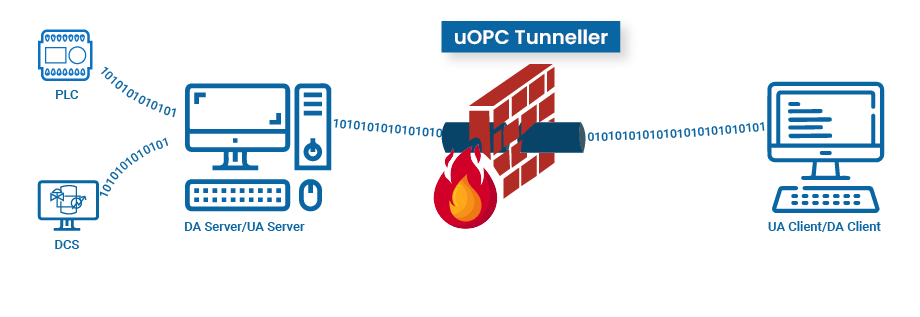- Publish date: 04/15/2021
- Product release date: 04/15/2021
- Product Webpage

uOPC Tunneller Server
OPC Tunneller or wrapper enables transferring OPC data from OPC server to the clients. It bridges the gap between OPC classic servers and clients in different networks and also connects an OPC DA client/server to an OPC UA server/client.
Utthunga’s uOPC® Tunneller Server is developed on our reliable and secure uOPC server architecture that is designed by our highly skilled OPC certified professionals. The product will enable OPC Classic to Classic and/or OPC Classic to UA communication by bypassing a lot of the COM/DCOM or firewalls configuration settings.
Why is the OPC Tunneller required for Industries?
OPC Classic is based on Microsoft’s COM (Component Object Model) technology. Typically, in an OPC Classic setup, for an OPC DA client to connect to the OPC DA server running in different networks, the right DCOM configuration is needed. The DCOM configuration settings are susceptible to changes either due to security or Windows patch updates. The DCOM security model defines the user accounts that have access to the application, as well as the user accounts from which an application can accept connections. Additionally Windows firewalls requires you to add the COM applications to the exclusion list for communicating over a network. In brief, not your average Joe task.
A tunneller eliminates the problems associated with DCOM while connecting OPC clients to servers. The tunneller is a combination of an in-built OPC wrapper and a proxy. It’s called a proxy server due to the fact that the DA client doesn’t identify the actual source of DA data. So it assumes that it is connecting to DA server and receiving that data while in reality the data is actually being tunneled through the OPC Tunneller.
OPC Tunnelling product provided by Utthunga
uOPC® Tunneller avoids the mess of DCOM configuration by using tunneller server and client components on the local systems which interface with the OPC Classic server and clients via local COM. On one side there is a tunneller server component which is an OPC DA to UA converter. It has the DA server that will connect or gather data and expose this data over OPC UA Server. On the other side there is the tunneller client component which is an OPC UA to DA converter. It has the OPC UA client which connects to this UA server and exposes the data to the OPC DA client.
The two uOPC tunneller components communicate with one another via OPC UA. The IT personnel managing the network infrastructure will add the port number and IP addresses of the servers and clients details in the firewall settings of the router as part of the port forwarding mechanism. No DCOM configuration is required and Windows firewall configuration is limited to allowing access to the port being used by the uOPC Tunneller components on the respective machines.
uOPC® Tunneller from Utthunga suite has the following features:
- Supports OPC Classic, OPC DA (v1.0, v2.0 and v3.0), OPC AE v1.0, OPC HDA v1.0, OPC UA v1.02
- Protocols Supported: OPC Client drivers for OPC UA, DA, AE & HDA
- Supports single instance for uOPC® Tunneller Client (also called as Proxy Server) when it connects to one or more OPC UA Tunneller Server(s)
- Supports dynamic runtime browse of new tags injection in OPC Classic server(s)
- Supports bulk tags per subscription
- Allows automatic reconnect
- Provides support for tracking status of underlying OPC Server(s)
- Provides support for OPC classic DA v1.0 connectivity in uOPC® Tunneller server
- Security is provided via data signing & encryption along with user authentication & authorization
- Target OS: Windows XP SP2, Windows 7 (32Bit/64Bit), Windows 8/8.1 (32Bit/64Bit), Windows 10 (32 bit/64 bit), Windows Server 2008 RS2 (32Bit/64Bit), Windows Server 2012 RS2
Why OPC Tunneller from Utthunga?
Utthunga’s uOPC® tunneling solutions help you to build a secure and reliable communication network without the fear of facing frequent configuration and security issues. uOPC® Tunneller helps your industrial automation communication to:
- Overcome OPC timeout issues and disconnections caused by DCOM setup
- Eliminate DCOM usage for OPC Classic connectivity and data transfer through firewalls
- Reduce costs by eliminating rip-and-replace of OPC Classic assets
- Reduce network bandwidth utilization and increases throughput
- Provide secure, encrypted & authentic communications between OPC Clients & Servers
- Use diagnostic tools for easy troubleshooting
Product details
Markets:
|
Category: Data Integration |
Supported Profiles and Facets
Application Profiles:
UACore 1.04
- Standard 2017 UA Server Profile
Security Policies:
UACore 1.04
- SecurityPolicy [B] – Basic256Sha256
- SecurityPolicy – Basic128Rsa15
- SecurityPolicy – Basic256
User Tokens:
UACore 1.04
- User Token – Anonymous Facet
- User Token – User Name Password Server Facet
- Data Access 2.05a
- Data Access 3.0
- Alarms and Events
- Historical Data Access




 go back
go back